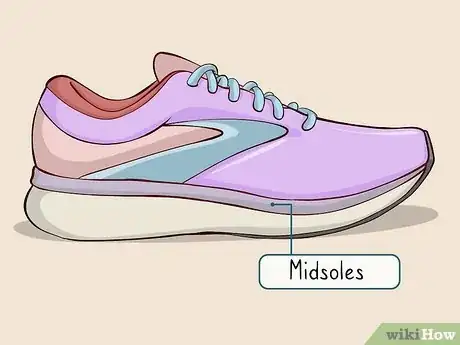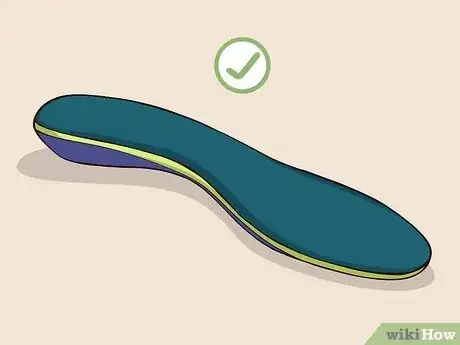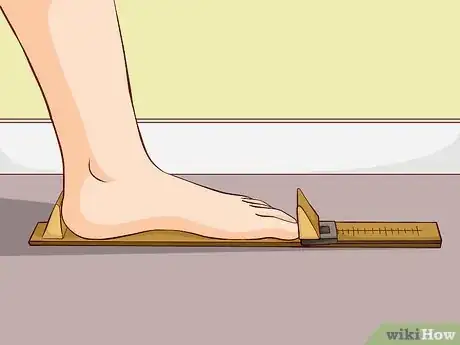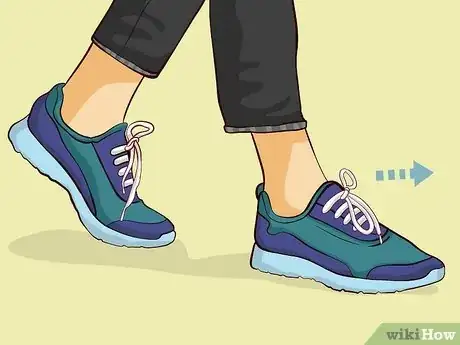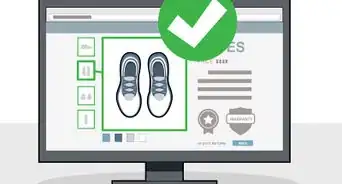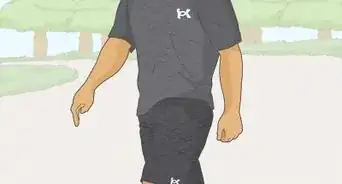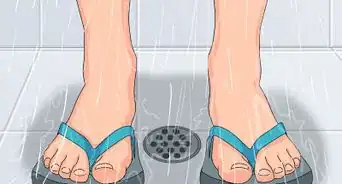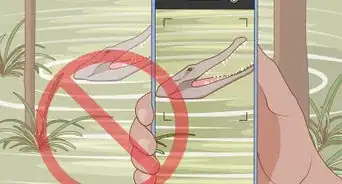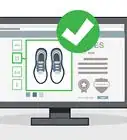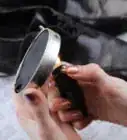X
This article was co-authored by Michele Dolan. Michele Dolan is a BCRPA certified Personal Trainer in British Columbia. She has been a personal trainer and fitness instructor since 2002.
This article has been viewed 140,980 times.
Walking is a stress-free, easy way to stay fit and healthy. Like with any other activity, having the right equipment is the key to success. To make sure that you choose the right walking shoe, look for important features, try them on in the store, and find a good fit.
Steps
Method 1
Method 1 of 3:
Looking for Important Features
-
1Support your heel with a snug heel counter. This area of the shoe should comfortably cup the back of your heel. If the heel counter fits correctly, then it can help keep your feet from pronating or supinating when you walk. Make sure that it feels nice and snug but not too tight.[1]
-
2Look for a shoe with slight roominess in the toe box. The toe box is the part of the shoe that surrounds your toes. It’s important that this part of the shoe allows your toes to wiggle and bend freely. However, too much space can cause excessive shifting and ultimately, discomfort. Shoot for a nice middle ground.[3]Advertisement
-
3Look for outsoles with good traction. The parts of your shoes that make contact with the ground are called the outsoles. Inspect this under part of the shoe to be sure that there are grooves. These will help create traction when you walk, which can prevent you from slipping and falling.
-
4Make sure the midsoles are made of cushioning material. Midsoles are arguably the most important part of the shoe. This is the area of the shoe between the upper part of the shoe and the tread.[4] Feel the midsoles with your hand to assess their softness and resiliency. Try on shoes with midsoles made of gel, foam, or air. All of these materials do a great job of cushioning and minimizing impact each time your foot hits the ground while you walk.
-
5Ensure good shock absorption with quality insoles. The soles of your feet should feel well-cushioned in your walking shoes. It’s crucial that your insoles shape well to your foot and are supportive because their job is to absorb the impact that your foot has on the shoe.[5]
- If you find a shoe that seems great in almost every area but doesn’t have quality insoles, you can always buy some gel inserts to get the support you need.
-
6Assess each shoe’s breathability. When you’re walking and getting your heart rate up, your feet may sweat a little. Make sure to get a shoe that has a breathable membrane and also always wear breathable socks when you’re walking. Shoes that trap the moisture can cause painful blistering and general discomfort.[6]
Advertisement
Method 2
Method 2 of 3:
Trying on Shoes
-
1Try the shoes on at the end of the day. Everyone’s ankles and feet swell at least some over the course of the day, so it’s better to try on shoes in the late afternoon or evening than in the morning. It’s better to get a shoe that feels a touch loose sometimes than one that’s too tight on your foot.
-
2Bring a pair of your own socks. In order to get a true idea of how a shoe fits, you’ll need to try it on with whatever kind of sock you usually wear, whether that means high, low, thick, or thin socks.
- Also bring inserts if you usually wear them.[7]
-
3Measure your feet. Each time you go shoe shopping, you should measure your feet. The size of your feet can change slightly over time. Either measure your feet yourself with the shoe sizer that’s in the store or have a friend, family member, or store employee help you. Measure both feet while standing up.
- If one foot is larger than the other, look for a shoe that fits the larger foot well.
-
4Do the wiggle test. When you put a pair of shoes on, wiggle your toes and see if you have enough space in them. You should have at least half an inch of room between the tip of your longest toe and the front wall of the toe box. If you don’t, try going up a size.
-
5
Advertisement
Method 3
Method 3 of 3:
Finding a Good Fit
-
1Make sure the width and length are both right. Calluses and blisters can form as a result of wearing a shoe that’s too narrow or wide. Wearing a shoe that’s too short can crowd your toes, which is especially painful and problematic if you have any deformities or disorders, such as bunions or hammertoes.
-
2Prioritize good motion control if you have low arches. Many who have flatter feet deal with problems involving muscle and joint stress. If you have significantly low arches, focus on finding a shoe with good motion control so that your feet can be better stabilized.
- Also, look for a shoe with a straight last. The last refers to the overall shape of the sole.
-
3Get a shoe with good cushioning if you have high arches. High arches put a lot of strain on muscles and joints because they don’t absorb shock as well. Look for a shoe that has a generous amount of cushioning if you have a higher arch in order to improve shock absorption.
- Try a shoe with a curved last.
-
4Look for firm midsoles if you have a neutral arch. In addition to straight or semi-curved lasts and moderate rear foot stability, neutral feet are best supported by firm midsoles. Make sure that your shoes have these features if you don’t think your foot falls under either arch type.
Advertisement
Community Q&A
-
QuestionI take a dress shoe size 8.5 with a medium width. Translated to a sneaker or walking shoe, what size should I be looking for?
 Community AnswerEvery shoe company's sizes fit slightly differently, so it's virtually impossible to recommend the right size. Go to a shoe store and try on a variety of sneakers in different sizes till you find one that feels good.
Community AnswerEvery shoe company's sizes fit slightly differently, so it's virtually impossible to recommend the right size. Go to a shoe store and try on a variety of sneakers in different sizes till you find one that feels good. -
QuestionI wear wide shoes and have an instep that you can literally see from one side to the other. I do have orthotics but need a good walking shoe. Any recommendations?
 Brianna Van DreelCommunity AnswerMy feet are the same way. I would recommend Asics Venture 5 shoes, they are wonderful for feet like ours!
Brianna Van DreelCommunity AnswerMy feet are the same way. I would recommend Asics Venture 5 shoes, they are wonderful for feet like ours! -
QuestionWhat do I do if one of my feet are bigger than the other?
 Community AnswerYou have to search a doctor. This might be a disease that's called Hemihypertrophy (Hemihyperplasia). You can search about it, but of course you have to be careful as it can just be your foot growing a bit more out of range and can grow on the same spot again. Also do not beware if it's not MUCH more bigger.
Community AnswerYou have to search a doctor. This might be a disease that's called Hemihypertrophy (Hemihyperplasia). You can search about it, but of course you have to be careful as it can just be your foot growing a bit more out of range and can grow on the same spot again. Also do not beware if it's not MUCH more bigger.
Advertisement
References
- ↑ https://www.spine-health.com/wellness/exercise/guidelines-buying-walking-shoes
- ↑ https://www.youtube.com/watch?v=PJLcyxfBYeE
- ↑ https://www.spine-health.com/wellness/exercise/guidelines-buying-walking-shoes
- ↑ https://www.spine-health.com/wellness/exercise/guidelines-buying-walking-shoes
- ↑ https://www.spine-health.com/wellness/exercise/guidelines-buying-walking-shoes
- ↑ https://www.mountainwarehouse.com/expert-advice/walking-shoes-guide
- ↑ http://www.aarp.org/health/fitness/info-2007/walking_shoes.html
- ↑ http://www.aarp.org/health/fitness/info-2007/walking_shoes.html
About This Article
Advertisement



